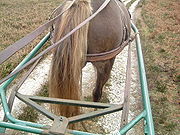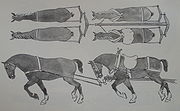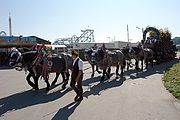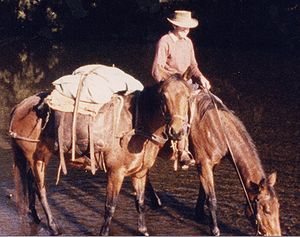
Breeching (tack)
Encyclopedia

Pack animal
A pack animal or beast of burden is a working animal used by humans as means of transporting materials by attaching them so their weight bears on the animal's back; the term may be applied to either an individual animal or a species so employed...
or riding animal. Both under saddle
Saddle
A saddle is a supportive structure for a rider or other load, fastened to an animal's back by a girth. The most common type is the equestrian saddle designed for a horse, but specialized saddles have been created for camels and other creatures...
and in harness
Horse harness
A horse harness is a type of horse tack that allows a horse or other equine to pull various horse-drawn vehicles such as a carriage, wagon or sleigh. Harnesses may also be used to hitch animals to other loads such as a plow or canal boat....
, breeching engages when an animal slows down or travels downhill and is used to brake
Brake
A brake is a mechanical device which inhibits motion. Its opposite component is a clutch. The rest of this article is dedicated to various types of vehicular brakes....
or stabilize a load.
Harness breeching


Horse
The horse is one of two extant subspecies of Equus ferus, or the wild horse. It is a single-hooved mammal belonging to the taxonomic family Equidae. The horse has evolved over the past 45 to 55 million years from a small multi-toed creature into the large, single-toed animal of today...
, mule
Mule
A mule is the offspring of a male donkey and a female horse. Horses and donkeys are different species, with different numbers of chromosomes. Of the two F1 hybrids between these two species, a mule is easier to obtain than a hinny...
, or other animal is in harness
Horse harness
A horse harness is a type of horse tack that allows a horse or other equine to pull various horse-drawn vehicles such as a carriage, wagon or sleigh. Harnesses may also be used to hitch animals to other loads such as a plow or canal boat....
, harness breeching (also known as full breeching) helps the animal to slow or control the forward movement of a vehicle
Horse-drawn vehicle
A horse-drawn vehicle is a mechanized piece of equipment pulled by one horse or by a team of horses. These vehicles typically had two or four wheels and were used to carry passengers and/or a load...
. Animal-drawn vehicles have either a pair of shafts or a single pole projecting forwards for about the length of one animal. An animal between shafts wears harness breeching, which attaches forward to the shafts. As the animal slows, the vehicle runs forward, and the shafts pull the breeching forward against the haunches of the animal, which can thus slow the vehicle. A vehicle with a pole has a pair of animals either side of it – their breeching works in a similar way, attaching forward to the pole either directly or by way of their collars. In a larger team, the leaders are in front of the shafts or pole and thus cannot slow the vehicle; nevertheless, they sometimes wear breeching for show.

Sulky
A sulky is a lightweight cart having two wheels and a seat for the driver only but usually without a body, generally pulled by horses or dogs, and is used for harness races...
used for harness racing
Harness racing
Harness racing is a form of horse racing in which the horses race at a specific gait . They usually pull a two-wheeled cart called a sulky, although racing under saddle is also conducted in Europe.-Breeds:...
or in a light cart used with fine harness
Fine harness
Fine harness is a type of driving competition seen at horse shows, that feature light, refined horses with high action. Popular breeds in this event include the American Saddlebred, Morgan, Arabian, Dutch Harness Horse, and Hackney ....
, the weight of the vehicle and passenger is little enough that the girth and crupper
Crupper
A crupper is a piece of tack used on horses and other equids to keep a saddle, harness or other equipment from sliding forward.-Construction:...
of the harness provide sufficient braking support. Breeching may also be omitted if the vehicle has efficient brakes on the wheels – examples include larger carriage
Carriage
A carriage is a wheeled vehicle for people, usually horse-drawn; litters and sedan chairs are excluded, since they are wheelless vehicles. The carriage is especially designed for private passenger use and for comfort or elegance, though some are also used to transport goods. It may be light,...
s and modern vehicles with disk brakes. Similarly, breeching and the requisite shafts or pole are not needed for a dragged load such as a plow or a log that will not move on its own, nor for a canal boat
Canal boat
There are three articles associated with canal watercraft:* The Volunteer - A replica 1848 canal boat docked on the Illinois and Michigan Canal at LaSalle, Illinois* Narrowboat - a specialized craft for operation in early narrow canals...
, which is towed by a long rope from the bank.
Historically, additional animals were sometimes used to brake very heavy vehicles on steep downhills, being hitched in harness breeching behind the load. This is still done when logging in very steep terrain.
Breeching is not normally used for ox
Ox
An ox , also known as a bullock in Australia, New Zealand and India, is a bovine trained as a draft animal. Oxen are commonly castrated adult male cattle; castration makes the animals more tractable...
en in yoke
Yoke
A yoke is a wooden beam, normally used between a pair of oxen or other animals to enable them to pull together on a load when working in pairs, as oxen usually do; some yokes are fitted to individual animals. There are several types of yoke, used in different cultures, and for different types of oxen...
s, where braking is provided by pulling back on the yoke or girth (depending upon the type of yoke).
False breeching
On a light vehicle with shafts, false breeching is sometimes fitted to the vehicle, instead of using harness breeching. A horizontal strap is attached between the shafts of the vehicle, just behind the animal. When the animal slows or goes downhill, the vehicle runs forward, pushing the false breeching against the haunches of the animal, which can then push backwards to slow the vehicle. False breeching is generally limited to use with well-trained, steady animals, because if the animal rearRear (horse)
Rearing occurs when a horse or other equid "stands up" on its hind legs with the forelegs off the ground. Rearing may be linked to fright, aggression, excitement, disobedience, or pain. It is not uncommon to see stallions rearing in the wild when they fight, while striking at their opponent with...
s or falls there is a risk of the false breeching running up over its back. It is sometimes used to help show off the animal's haunches, which would be partly covered by harness breeching.
Saddle breeching
On both pack and riding stock, if breeching is used then generally a breastplateBreastplate (tack)
A breastplate is a piece of riding equipment used on horses. Its purpose is to keep the saddle or harness from sliding back....
is used as well.
Pack animals

Pack saddle
A pack saddle is any device designed to be secured on the back of a horse, mule, or other draft animal so it can carry heavy loads such as luggage, firewood, small cannons or other weapons too heavy to be carried by humans, etc.-Description:...
of a packhorse
Packhorse
.A packhorse or pack horse refers generally to an equid such as a horse, mule, donkey or pony used for carrying goods on their backs, usually carried in sidebags or panniers. Typically packhorses are used to cross difficult terrain, where the absence of roads prevents the use of wheeled vehicles. ...
or other pack animal, by keeping the saddle from sliding forward, especially on downhill tracks. Pack horse breeching may be supplemented with a crupper
Crupper
A crupper is a piece of tack used on horses and other equids to keep a saddle, harness or other equipment from sliding forward.-Construction:...
to provide additional stability.
Riding animals
Breeching is occasionally used in a similar manner as that of a pack saddle, especially when riding muleMule
A mule is the offspring of a male donkey and a female horse. Horses and donkeys are different species, with different numbers of chromosomes. Of the two F1 hybrids between these two species, a mule is easier to obtain than a hinny...
s. Mules often have lower withers
Withers
The withers is the ridge between the shoulder blades of a four-legged animal. In many species it is the tallest point of the body, and in horses and dogs it is the standard place to measure the animal's height .-Horses:The withers in horses are formed by the dorsal spinal processes of roughly the...
and flatter backs than horses, making it likely that the saddle will slide forward when going downhill with a rider. However, a crupper
Crupper
A crupper is a piece of tack used on horses and other equids to keep a saddle, harness or other equipment from sliding forward.-Construction:...
is more commonly used on riding animals in general.

